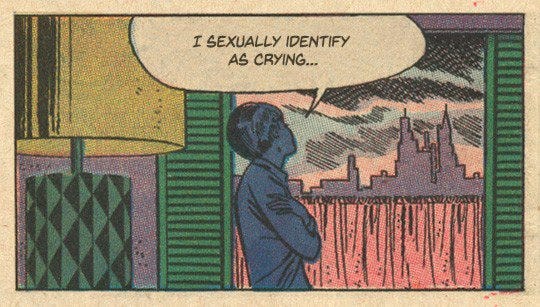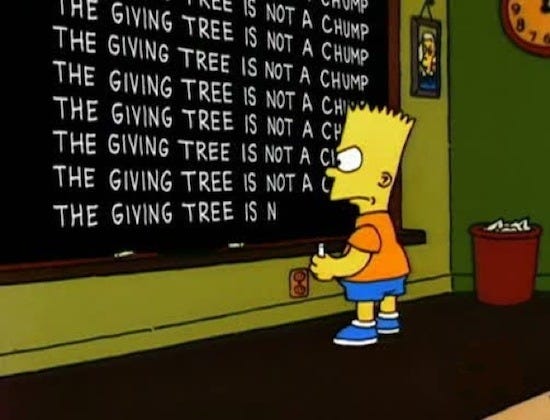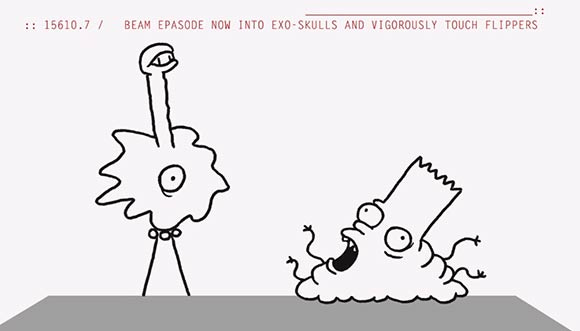Episode 115: Are you a Lisa or a Homer?

POP CULTURE SPIRIT WOW
Last Sunday The Simpsons ran its 600th episode. It's our longest running sitcom, longest running animated program and longest running prime time program. Give it one more year and it will also top “Gunsmoke” for the most episodes of any U.S. show ever.
Bizarrely, it’s one of those shows that kind of fell through the cracks for me. It debuted in 1989, when I was a junior in college, and though it was an immediate breakout hit, the audience that really "got" it initially were I think just a little bit younger than me, kids in middle school and high school.
It was also on FOX, which at the time was a brand new network, in fact a brand new concept, a network that was not ABC, CBS or NBC. And I am a notoriously bad judge of new things. It took me four years to agree to try “Breaking Bad”, five to try “Buffy the Vampire Slayer”. I’ve still never seen “Star Wars”.
Okay, one of those three statements was maybe not quite true.

55 DAYS
(I honestly don’t know what to say to people my age or younger who have never seen a “Star Wars” movie. Like, at this point that’s not an accident, that’s a conscious choice. It's like saying you’ve never eaten meat. Or stepped outside. Or gone by a name. Or felt joy. All I can think to say is, Why do you hate yourself?)
But even if you weren’t watching “The Simpsons” in those early years, you knew about it. Its breakout character Bart Simpson was everywhere – on T-shirts, cups, videogames. And his “screw being a good boy” attitude was transformational. Bill Cosby – who at the time had the biggest show on television, and was considered a voice of reason and civility, a wisdom figure (I know -- insert comments about horrifying realities and sick, despicable men here) -- called Bart “angry, confused, frustrated.”
Simpsons’ creator Matt Groenig agreed. “That sums up Bart, all right. Most people are in a struggle to be normal [and] he thinks normal is very boring, and does things that others just wished they dare do.”
BOOM.
It really was "All in the Family" for a new generation, a show that like contemporaneous "Roseanne" was willing to present family as warts in all, and in doing so kind of liberated the stories we could tell about adolescence, family...life. Certainly "South Park" or "Beavis and Butthead" don't happen without "The Simpsons". But I'm not sure "The Office" does either -- Ricky Gervais has actually said that his shows' characteristic "Wow that's uncomfortable" moment-style come directly from Groenig.
Likewise, Jon Stewart's "Daily Show" and spinoff "The Colbert Report" had writers from "The Simpsons", and it shows in their distinctive combination of absurdity and vicious social commentary.
Who could have thought an animated show about of all things neon-yellow people could be so important or long lasting. And yet here we are. ++ Speaking of that crazy coloring, Groening said he wanted them so bright and weird so that when people were channel surfing they would immediately recognize the show.
The names of the characters have a funny story, too. Apparently Groenig had to improvise a pitch for the show at the last minute; and so he named all the characters after members of his family. Bart was was the stand-in for himself; he chose that name because it's an anagram for “Brat”.
Other fun facts: Bart is supposedly 10. Lisa is 8. Maggie is 1. Maggie's first word, spoken in the tenth episode of the fourth season, was "Daddy". They got Elizabeth Taylor to record it. She supposedly walked out after Groenig made her do twenty takes. He felt she kept making it sound too sexy.
(She's since been voiced by not only series regulars but Jodie Foster and, I'm not kidding, James Earl Jones.) ++ One of the greatest elements of the show has to be the opening titles. Each week “The Simpsons” begins with a long sequence in which we follow the five members of the Simpson family in their lives and on the way home to join the rest of the family around the television for the night. (All of it a fascinating take on what it meant to be family in the 80s.)
Groenig made the sequence as long as he did – it’s over a minute, and sometimes over two – basically because he knew how difficult and time consuming producing episodes of the show would be. (Each episode takes six months to produce, believe it or not.) Having one long sequence at the beginning that was the same every week meant one-two minutes less new material that had to be produced.
At the same time, Groenig also set up a couple places in the sequence for ongoing gags, so that viewers would not get bored. So each week Bart is found after school at the chalkboard writing a line over and over, but the content changes.


And one for all the "Family Values" people who hated him (hi Million Moms):

The show, which has always involved social commentary – we’re talking a show set in a town where people happily work and live around a nuclear reactor – has often used the Chalkboard Gag to brilliant effect. “Five days is not too long to wait for a gun,” Bart writes in one episode. “The Wall Street Journal is Better than Ever.” “Network TV is not dead.” Every ridiculous claim being made in our world was happy fodder for "The Simpsons".
It could also get wonderfully meta, like the gag “I should not be twenty one right now,” a reference to the fact that the characters on the Simpsons never age. Or this hilarious bit about comedian and writer Kristen Schaal.

The opening has other gags, too – Lisa's music solo (which also inspired the ending to that fantastic title sequence for "Bojack Horseman") ; a billboard outside the school.
But the biggest and often most interesting gag that Groenig came up with – and one that sometimes completely defeats the purpose of having a long always-the-same opening -- is what’s called “The Couch Gag”, the moment they all arrive in their living room and sit on the couch to watch TV.
If you look here, you can find most of the couch gags from the early seasons. It’s really fascinating to watch; you see the writers play with this question of how to make rushing to a couch together funny and new week after week. There’s obvious gags, like not everyone in the family fitting on the couch, or the couch tipping over. Those gags get variations -- now the couch falls through the wall or through the floor; then new elements are added, like the appearance of someone else on the couch or a sudden synchronized moment of activity. Those elements, too, get variations – watch where the small synchronized moments lead -- or get reintroduced later back into the original idea in unexpected ways.
And the longer the show goes on, the more you see the writers realizing they're really only bound by their own imaginations. The characters suddenly run off the cartoon strip in one opening; in another they have each other’s heads; in a third they arrive to find another set of themselves already there.

In recent years the opening has been used to offer parodies of shows like Breaking Bad, Game of Thrones, Miami Vice or French cartoons. In 2011 they threw it out entirely to do this parody of the (way too) many YouTube videos where a whole school, office or (ugh) wedding party lipsyncs to a pop song.
Some of the greatest openings have been the work of other artists. In 2012 artist Bill Plympton turned the couch moment into a strangely sweet love story about Homer and his couch (which begins with the image above). Academy Award nominated cartoonist Don Hertzfeld likewise created this insane futuristic piece that boils each character down to their weird minimalistic essence (as in Lisa and Bart below).

Perhaps the high point (so far) came in 2010 when guerilla artist Banksy which used the couch moment to jump into a critique of Western consumer culture. I could describe it, but you really should watch it for yourself. It is not only the darkest thing the Simpsons has ever done but one of the most damning attacks on one’s viewers that any show has ever attempted. (Truly, if you watch no other clip mentioned in this newsletter, watch that one; it will make you think about a lot of things.) ++

Cultural commentator Todd VanderWerff recently ranked the members of the Simpsons family in terms of how well they carry stories. And as I was reading it I found myself wondering, which character do I most identify with?
I wish I could say Bart, because I think most of the time he’s having the most fun (even if it’s often sort of wasted on him). But Lisa is a lot closer to the school kid version of me – overachieving, idealistic, straight-laced. She’s also more or less the point of view character of the show, that is, the “normal” person in this crazy world.
(Random aside: for those who like “Modern Family”, I think middle daughter Alex is basically the live action version of Lisa, the “straight”, grounded character asked to take care of all the crazy around her. If you think about it, she and patriarch Jay are actually the only characters on that show that don’t have some zany characteristic that makes them just a bit off.
It’s been interesting to see the show’s writers, instead of eventually giving Alex some additional goofball twist for laughs, as they quickly did with her mom Claire, have instead mined her more ordinary-human-being nature for moments of real drama. Episode 512, “Under Pressure”, where Alex sends herself to the shrink to talk about how scared she is of failing and the challenge of being the one in her family not like the others, was almost entirely serious and completely fantastic.
Last season, having learned that serious can actually work for the show, you see the writers doing more of it with Alex, and also to great success with older sister Haley.
Generally the adults of “Modern Family” get all the attention, but Ariel Winter (Alex) is such a talent. And boy, can she sing.)

God I love this kid.
So, if the fact that I just spent four paragraphs praising a kid not on "the Simpsons" who is also a high-achieving semi-stressed-out nerd and probably has an ulcer like I did when I was 16 doesn’t suggest I identify with that kind of character, I don’t know what could.
But strangely, the more I sat with the Simpson characters, the more I realized I actually identify the most with Homer. I know, it's weird, right? He eats like a pig, his shirt is usually stained. He is the guy you see at the end of the bar who has been there all day and is sleeping in a pool of his drool. The definition of “sad” and “yuck” and "gross".
But I think he also captures for me a bit of what it’s like to be middle aged, the sense of one’s own absurdity and also of a certain unavoidable aimlessness. Whether you have a clear sense of self and purpose or not, in middle age it seems like there’s also a growing underlying awareness that a lot of the clear answers you used to wield so easily don’t ring true, not really, and that no matter how well you’re able to hide it behind a nice suit or fancy job title, physically and emotionally you’re kind of a mess, and easily scared, and maybe not that smart after all.
And at the same time – and this is what stops it from being a precursor to binge drinking to Sarah McLachlan’s Christmas album (literally the saddest thing that has ever been made) – watching Homer I also kind of feel better about all that. People are silly and messy and awkward and often bad at what they do and not particularly nice or attractive without their clothes on, and that’s okay. It’s all okay.
And I don't know, maybe there's an invitation in there to start to let go of some of the unrealistically high expectations, or even consciously and openly to embrace the occasional bout of ridiculous, Bart- or Homer-like irresponsibility.

Or maybe I just want a good excuse for late night trips to Randy's Donuts.
++ LINKS ++
There was another debate this week. If you watched it, I hope you're taking care of yourself.
One thing I found that's helping me this week when things start looking "Darkest Timeline" is to watch this scene from, of all things, The Price is Right.
This clip about a real life Spider-Man is pretty great, too. (I know, it's just an ad, but it also turns out to be true -- and at a bunch of places.)
Or you can take a moment to consider some much more important questions:

We're almost there. Be sure to pack a nice lunch. I hear the weather is going to be amazing.

